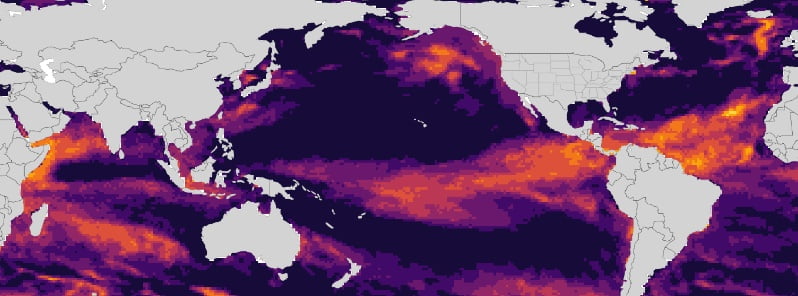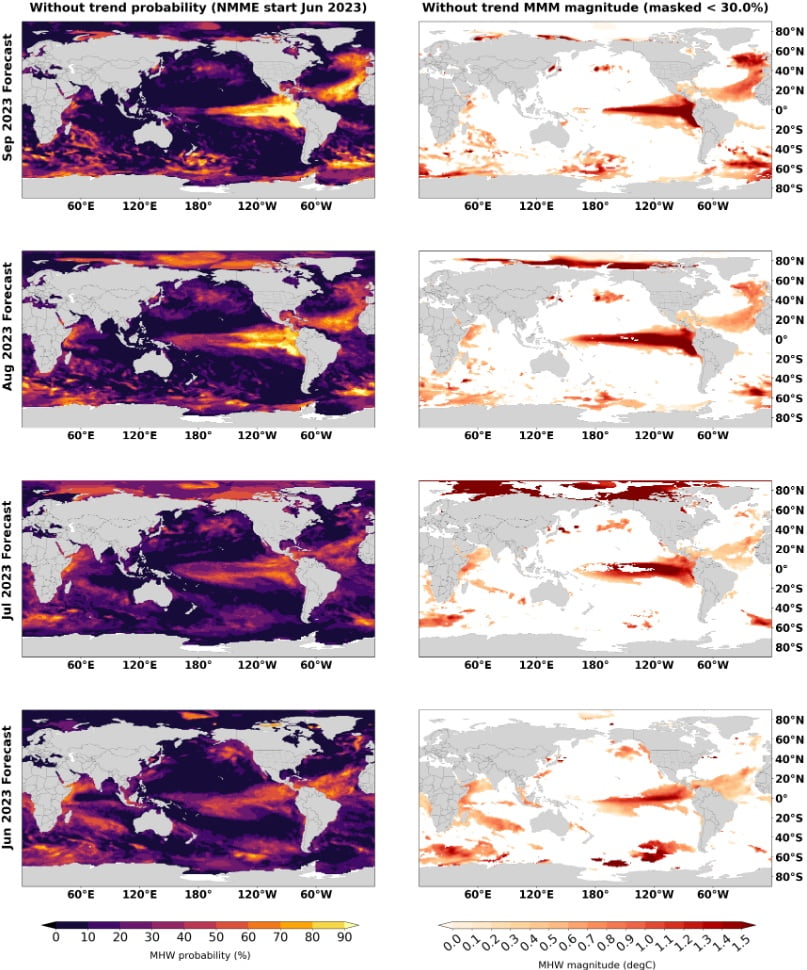NOAA forecast indicates increase in global marine heatwaves through May 2024

Global marine heatwave (MHW) conditions continue to escalate, with around 40% of the ocean currently affected. Predictions for September 2023 estimate an increase to 50%, according to June 2023 forecast by NOAA’s Physical Sciences Laboratory.
Marine heatwaves are periods of persistent anomalously warm ocean temperatures, which can have significant impacts on marine life as well as coastal communities and economies.
Currently, about 40% of the global ocean, or 25% when the long-term warming trend is removed, is experiencing MHWs, placing it first among all months since 1991. Notably affected regions include the equatorial Pacific, the Northeast Pacific, the Northwest Pacific in the Kuroshio extension region, and the Sea of Japan, the tropical North Atlantic, the Northeast Atlantic along the Iberian coast up to Ireland and the UK, the Southwest Pacific southeast of New Zealand, and the Western Indian Ocean southeast of Madagascar.
Forecasts for September 2023 anticipate that approximately 50% of the global oceans, or 25% when the long-term warming trend is removed, will experience MHW conditions.
Notable regional forecasts are as follows:
The Tropical Pacific is expected to continue experiencing MHW conditions through the end of the year with a 70 – 80% chance, and 50 – 60% chance when considering the long-term warming trend. The intensity of the anomalies is also predicted to grow as El Niño continues to develop.
For the Northeast Pacific, MHW conditions offshore are anticipated to persist through at least November 2023 with a 50 – 60% chance, or 30 – 40% chance when the long-term warming trend is considered. MHW conditions along the Pacific Northwest coastline are predicted to start from March 2024 with a 70 – 80% chance, or 40 -5 0% chance when considering the long-term warming trend.
In the Northwest Pacific, MHW conditions are expected to persist through September 2023 in the coastal waters east of Japan with a 70 – 80% chance, or 40 – 50% chance when considering the long-term warming trend, and in the Sea of Japan with a 50 – 60% chance. The intensity of the MHWs may also intensify during this period.
In the Atlantic (Ireland/UK), MHW conditions are anticipated to persist west of Ireland and in the Irish/Celtic Seas through August 2023 with a 50 – 60% chance, with intensities expected to decrease during that time.
The North Atlantic is predicted to experience MHW conditions through August 2023 with a 90 – 100% chance, or 80 – 90% chance when considering the long-term warming trend, and possibly through the end of 2023 with a 70 – 80% chance, or 40 – 50% chance when considering the long-term warming trend.
In the Indian Ocean, MHW conditions are expected to persist off the southeast coast of Madagascar through September 2023 with a 70 – 80% chance, or 30 – 40% chance when the long-term warming trend is considered. The primary MHW area is expected to shift to the coastal regions near the Horn of Africa over the next 3 months with an 80 – 90% chance, or 60 – 70% chance when the long-term warming trend is taken into account.

Marine heatwave forecasts are experimental and intended for research purposes, NOAA’s Physical Sciences Laboratory noted.
References:
1 Marine Heatwave Forecast Monthly Report – June 2023 – NOAA/PSL
Featured image credit: NOAA/PSL

Commenting rules and guidelines
We value the thoughts and opinions of our readers and welcome healthy discussions on our website. In order to maintain a respectful and positive community, we ask that all commenters follow these rules.